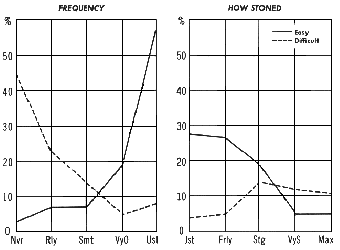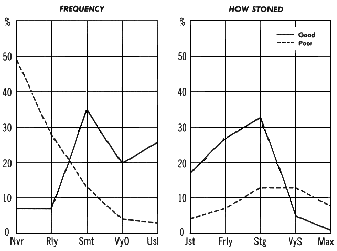Chapter 20. Sleep and Dreams
| Books - On Being Stoned |
Drug Abuse
Chapter 20. Sleep and Dreams
MAJOR EFFECTS
Falling Asleep
One of the most characteristic effects of marijuana intoxication is "I find it very easy to go to sleep at my usual bedtime when stoned" (3%, 7%, 7%, 19%, 57%), which begins to occur at the lowest level of intoxication (28%, 27%, 19%, 5%, 5%). The linked opposite effect, "I find it very difficult to get to sleep when stoned, even if it's my usual bedtime" (45%, 23%, 14%, 5%, 8%) occurs far less frequently (p < .001), and from Strong to Maximal levels (4%, 5%, 14%, 12%, 11%), as shown in Figure 20-1 below. Ease of going to sleep is generally associated with a much lower minimal level of intoxication (p <.001) than is difficulty, also shown in Figure 20-1, although many (53 percent) of the users could not rate the minimal level of intoxication of the latter effect. |
| Figure 20-1. GETTING TO SLEEP STONED Note.—For guide to interpreting the "How Stoned" graph, see note on Figure 6-1. |
The Professionals indicate somewhat lower levels of intoxication for ease in falling asleep, compared to the College-educated (p <.05).
Early drowsiness is very common: "I get very drowsy even though it's not late or otherwise close to my usual bedtime," (2%, 13%, 45%, 25%, 12%). The modal minimal degree of intoxication for this is Strongly, with 76% of the users rating this in the Fairly to Very Strongly Stoned range (9%, 17%, 38%, 21%, 7%). Several background factors strongly affect the level of intoxication for this phenomenon.
Heavy Total users have Very Strongly/ Maximum as modal response categories of intoxication levels, while Medium and Light Total users have Fair/Strong as modal categories (p <.001, overall). A similar finding occurs when frequency of use in the last six months is the background factor (p <.01, overall), the Daily users again indicating Very Strongly/Maximum as modal levels, the Weekly users indicating Fairly and Strongly modally (with Very Strongly and Maximum also quite frequent), and the Occasional users having a mode at Fairly/Strongly.
Meditators experience early evening drowsiness at lower levels of intoxication (p <.001).
A related, rare phenomenon dealt with fully in Chapter 15 is "My mind goes completely blank for long periods (15 minutes or more); even though I'm not asleep, I have no thoughts or images or anything going on my mind." It may very well be that this high-level phenomenon actually represents sudden periods of sleep overwhelming the user.
Quality of Sleep
 |
| Figure 20-2. QUALITY OF NIGHT'S SLEEP AFTER GOING TO BED STONED Note.—For guide to interpreting the "How Stoned" graph, see note on Figure 6-1. |
The effect of marijuana intoxication on ease or difficulty of going to sleep is paralleled by the reported effects on the quality of sleep: "My sleep is particularly refreshing if I go to bed stoned," (7%, 7%, 35%, 20tXo, 26%) is very common, while the linked opposite, "My sleep is restless and poor if I go to bed stoned," (49%, 28%, 13%, 4%, 3%) is rare (p <.001). Figure 20-2, below, presents the distributions for frequency of occurrence and minimal level of intoxication for these effects. Disturbed sleep usually begins at higher levels of intoxication (p <.001); levels are 17%, 27%, 33%, 5%, 1% for refreshing sleep and 4%, 7%, 13%, 13%, 8% for disturbed sleep.
The refreshing quality of sleep is affected by frequency of use; Weekly and Daily users have somewhat higher minimal levels of intoxication for this than Occasional users (p <.05, overall).
Dreaming
Two questions dealt with the effect of marijuana on recalled dreaming. "My dreams are more vivid if I go to bed stoned" is common (23%, 18%, 23%, 16%, 12%), but its opposite, "My dreams are less vivid or forgotten if I go to bed stoned" (23%, 27%, 21%, 7%, 13%) occurs about as frequently. Both effects have the same distribution of minimal intoxication levels (7%, 18%, 28%, 9%, 2% and 11%, 23%, 17%, 10%, 3%, respectively). Thus the effects of marijuana on the dreaming process must be modulated by immediate situational and psychological factors rather than dosage per se. Heavy Total users rate Fairly/Strongly and Very Strongly/Maximum about equally for less vivid dreaming, while Low and Moderate Total users peak sharply at Fairly/Strongly (p <.05).
LEVELS OF INTOXICATION FOR SLEEP PHENOMENA
The effects of marijuana intoxication on sleeping and dreaming are ordered by level of intoxication in Figure 20-3. Overall differences between levels are highly significant (p <<<.0005). At the lower levels we find ease of falling asleep at bedtime. As we go up a level, effects on dreams may manifest and a refreshing quality may be added to sleep. The next higher level indicates possible early evening drowsiness, and the next two levels above that possible poor sleep and difficulty in going to sleep, respectively. Unrecognized sleep attacks may occasionally occur at the highest levels. Early evening drowsiness being in the midrange of the intoxication levels might indicate a change in the nature of intoxication from a tranquilizing or sedative effect to a predominantly excitatory effect at high levels.[1]
| Just | Fairly | Strongly | Very Strongly |
Maximum | |||||
|
|
|||||||||
|
|||||||||
| Mind goes blank | |||||||||
| DIFFICULT TO FALL ASLEEP | |||||||||
| Sleep poor, restless | |||||||||
| EARLY DROWSINESS | |||||||||
| DREAMS MORE VIVID | |||||||||
| DREAMS LESS VIVID | |||||||||
| SLEEP PARTICULARLY REFRESHING | |||||||||
| EASY TO GO TO SLEEP AT BEDTIME...?.* | |||||||||
|
|
|||||||||
MODULATING FACTORS
All the background factors affecting sleep and dream phenomena had relatively linear effects. They are summarized in Table 20-1.In general, more experience with drugs tends to push some of the disagreeable phenomena of marijuana intoxication to higher levels of intoxication.
| BACKGROUND FACTORS | EFFECTS | |
|---|---|---|
| More Drug Experience | More Intoxicated for: Early drowsiness Sleep particularly refreshing Dreams less vivid |
|
| Older | Less intoxicated for: Mind goes blank |
|
| More Educated | Less intoxicated for: Easy to go to sleep at bedtime |
|
| Meditation | Less intoxicated for: Early drowsiness |
|
| Males | Less frequent: Mind goes blank |
|
SUMMARY
In general, users report that marijuana frequently produces early drowsiness, ease of going to sleep at bedtime, and an especially refreshing sleep. Given the widespread existence of problems of sleeping in this country, reflected in immense sales of both proprietary and prescription medications for aiding sleep, further investigation of the sedative effects of marijuana is called for. Further, most of the effective sleeping medications available as prescription drugs have undesirable side effects, such as lethargy the following morning.[2] Although not specifically dealt with on the questionnaire, my informants have indicated that lethargy following an evening of marijuana intoxication is rare and usually associated with very high levels of intoxication.
The general effects of drowsiness, ease or difficulty of going to sleep, and quality of sleep are modulated by a number of factors, which suggest a general dimension of control over the marijuana state. In the intoxicated state a great deal of mental activity and experience is occurring, more so at higher levels of intoxication. With too much mental activity, drowsiness is warded off, and sleep may be poor. Also, as emotional states tend to be amplified by marijuana, an unpleasant emotional state may demand more attention, be harder to inhibit. Thus users who have more experience generally with marijuana or other psychedelic drugs apparently acquire more familiarity with the working of the state and more ability to control its manifestation, and so are not troubled as frequently with negative effects such as difficulty with sleep, except at higher levels of intoxication where control is more difficult.
Footnotes
1. Note that these effects are for the level of intoxication at the time of going to sleep. Since most users smoke marijuana early in the evening, they may experience high level effects for the first couple of hours, but have come down to a lower level by bedtime, avoiding the problem of the adverse effects of high levels of intoxication on sleep. (back)
2. Numerous studies have found that effective sedative drugs uniformly disrupt the natural sleep-dream cycle (see Kales, 1969, for some recent summaries of these effects). No data is available at the time of this writing on whether marijuana does this also. (back)
| < Prev | Next > |
|---|












